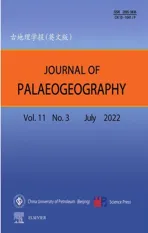Intensive peatland wildfires during the Aptian-Albian oceanic anoxic event 1b:Evidence from borehole SK-2 in the Songliao Basin, NE China
2022-08-19ZhiHuiZhngWeiTinTinWngDongZhoAnHiYnLiuDongDongWngChengShnWng
Zhi-Hui Zhng , D-Wei Lü ,*, Tin-Tin Wng ,Dong-Zho An , Hi-Yn Liu , Dong-Dong Wng ,Cheng-Shn Wng
a Shandong Provincial Key Laboratory of Depositional Mineralization and Sedimentary Minerals, College of Earth Sciences and Engineering, Shandong University of Science and Technology, Qingdao 266590,Shandong Province, China
b Institute of Earth Sciences, China University of Geosciences, Beijing 100083, China
c School of Earth Sciences and Resources, China University of Geosciences, Beijing 100083, China
d Chinese Academy of Geological Sciences, Beijing 100037, China
Abstract The Cretaceous has been considered a“high-fire”world accompanied by widespread by-products of combustion in the rock record. The mid-Cretaceous oceanic anoxic event 1b (OAE1b) is marked by one of the major perturbations in the global carbon cycle characterized by deposition of organic-rich sediments in both marine and terrestrial settings.However,our understanding is still limited on changes in wildfire activity during OAE1b period. Here, we carried out a comprehensive analysis, including organic carbon isotope(δ13Corg), total organic carbon (TOC), coal petrology, trace elements, and pyrolytic polycyclic aromatic hydrocarbons (pyroPAHs), of coal seams of the middle Aptian to early Albian Shahezi Formation from borehole SK-2 in Songliao Basin, Northeast China. Two negative δ13Corg excursions in the Shahezi Formation can be corresponded with the 113/Jacob and Kilian sub-events of OAE1b. Moreover, the intensive peatland wildfires have been identified during the sub-event periods of OAE1b based on the co-occurrence of high abundance of charcoal and pyroPAHs at that time. In addition, Sr/Ba, Sr/Cu and Sr/Rb ratios demonstrate that enhanced peatland wildfires were controlled by dryer climate conditions owing to episodic northward migration of arid zones in East Asia related with rising global temperature during the sub-events of OAE1b. The climate-driven extensive wildfire activity in the mid-latitude terrestrial ecosystems can be a contributing factor for OAE1b through the increased flux of nutrients fuelling primary producers in the lake and marine environments and leading to more speculative anoxia to allow the deposition of organic-rich sediments. Our results provide essential understanding of the importance of wildfires in driving mechanism of oceanic anoxic events(OAEs)in Earth's history.
Keywords Lower Cretaceous, OAEs, Peatland, Wildfire, Coals
1.Introduction
The Aptian-Albian oceanic anoxic event 1 b(OAE1b)is marked by four sub-events(i.e.,113/Jacob,Kilian, Urbino/Paquier, and Leenhardt) (e.g.,Schlanger and Jenkyns, 1976; Coccioni et al., 2014)that are characterized by organic-rich black shale horizons and major perturbations in the global carbon cycle (Jenkyns, 2010). This OAE has been intensively investigated in the Tethys, Atlantic and Pacific Ocean Basins (Leckie et al., 2002; Herrle et al., 2004;Trabucho Alexandre et al.,2011;Coccioni et al.,2014;Navarro-Ramirez et al., 2015; Sabatino et al., 2018;Matsumoto et al., 2020). Moreover, a few contemporaneous terrestrial deposits have been received more focus over time for a comprehensive understanding of OAE1b (Ludvigson et al., 2010; Hu et al., 2014; Xu et al., 2020, 2022; Zhao et al., 2022). The trigger of OAE1b is hypothesized to link with the formation of the southern Kerguelen Plateau(Coffin and Eldholm,1994;Coffin et al., 2002; Sabatino et al., 2018; Xu et al.,2022),increasedthermohalinestratification(Erbacher et al., 2001), extreme monsoonal activity(Herrle et al., 2003; Friedrich et al., 2005; Benamara et al., 2020), methane gas hydrate dissociation(Zhang et al., 2016), and sea level changes (Erbachen et al.,1998;Leckie et al., 2002).
Wildfires have played an important role in Earth's terrestrial ecosystems since the appearance of the first land plants during the Late Silurian (~420 Ma) (Scott and Glasspool, 2006; Belcher, 2013). Wildfire behavior in geological history can be identified through changes in the by-products of combustion, including fossil charcoal,inertinite(fossil charcoal in coal),and pyrogenic polycyclic aromatic hydrocarbons (pyro-PAHs) (Glasspool and Scott, 2010; Baker, 2022). Variations in wildfire activity in Earth's past are influenced by changes in atmospheric oxygen concentration,climate, and vegetation over both short and long timescales(Belcher and Hudspith,2017;Baker,2022).The oceanic anoxic events (OAEs) represent the periods throughout Earth's history that experienced major climatic and environmental changes (Schlanger and Jenkyns, 1976; Jenkyns, 2010), and therefore may have recorded variations in wildfire activity.Indeed, a statistically significant increase in wildfire activity has been reported within the Jurassic Toarcian OAE (T-OAE) and the Cretaceous OAE2 at the Cenomanian-Turonian boundary, based on a higher abundance of combustion by-products (i.e., charcoal and pyroPAHs) (e.g., Baker et al., 2017, 2020;Boudinot and Sepúlveda, 2020). However, our understanding is still limited on whether and how climate change during the OAE1b period affects wildfire activity.
In this study,we focus on the coal seams of Shahezi Formation from the International Continental Scientific Drilling Program (ICDP) borehole SK-2 in the Songliao Basin in Northeast China to understand peatland wildfire record during OAE1b. Based on the precise U-Pb zircon ages in the Shahezi Formation (Yu et al., 2020;Liu et al.,2021),total organic carbon(TOC)and organic carbon isotope(δ13Corg)were analyzed to recognize the sub-events of OAE1b. Identification of increased inertinite abundance and high pyroPAHs concentration was used to be indicative of intensive peatland wildfire activity. Climate condition (i.e., dry versus wet) was inferred from geochemical proxies(e.g.,Sr/Cu,Sr/Ba,and Sr/Rb). Our results provide the first peatland wildfire evidence to understand climate-driven terrestrial wildfire activity changes across OAE1b.
2.Geological setting
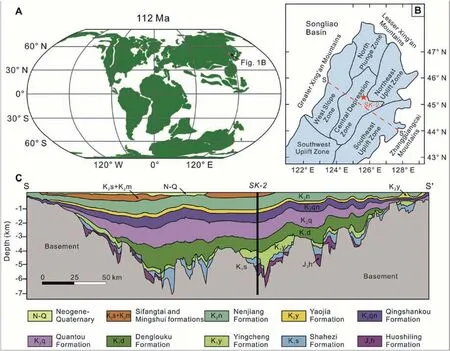
Fig.1 A)Paleogeographic position of the Songliao Basin at the start of the Albian(112 Ma)(modified from the Gplates Portal:http://portal.gplates.org/map/); B) Schematic map showing the first-order tectonic units and location of borehole SK-2 in the Songliao Basin, NE China(modified from Wu et al., 2014); C) Structural cross section (S-S′) across the central part of the Songliao Basin based on regional seismic analyses (modified from Feng et al., 2010). The black bar in the section is drilling interval of borehole SK-2.
The Songliao Basin (Fig. 1A), with an area of~260,000 km2in northeastern China, is one of the largest continental basins in the world and contains nearly complete Cretaceous terrestrial sedimentary records (Wu et al., 2009; Wang et al., 2016).Geographically,it is surrounded by the Greater Xing'an Mountains to the west,the Lesser Xing'an Mountains to the north, and the Zhangguangcai Mountains to the east (Fig. 1B). The Songliao Basin was formed by extension linked with westward subduction of the paleo-Pacific Plate underneath the Asian continental margin and/or upwelling of a mantle plume (Okada,2000; Wu et al., 2014). The geologic evolution of the basin mainly experienced four stages: mantle upwelling, rifting, post-rift thermal subsidence and structural inversion (Wang et al., 2006; Feng et al., 2010).
The Songliao Basin is filled with about 7000 m-thick Mesozoic to Cenozoic sediments underlain unconformably by Precambrian to Paleozoic metamorphic and igneous rocks, and Paleozoic to Mesozoic granite basement (Pei et al., 2007; Wang et al., 2007). The overlying strata of the Upper Jurassic to Cenozoic can be divided into 13 lithologic formations, including Huoshiling (J3h), Shahezi (K1s), Yingcheng (K1y), Denglouku (K1d), Quantou (K2q), Qingshankou (K2qn),Yaojia (K2y), Nenjiang (K2n), Sifangtai (K2s), Mingshui(K2m), Yi'an (E2y), Da'an (N1d), and Taikang (N2t) formations(Figs.1C and 2A)(Ren et al.,2002;Wang et al.,2007; Feng et al., 2010; Gao et al., 2015). The Lower Cretaceous Shahezi Formation, with a general thickness of about 400 m-1500 m, was deposited during rifting period in the middle stage of the faultcontrolled subsidence in Songliao Basin (Feng et al.,2010). This formation consists of conglomerate, sandstone, mudstone, and coal beds, deposited in alluvial fan-delta and lacustrine environments (Feng et al.,2010). The paleolatitude of the Songliao Basin in the Early Cretaceous was similar to that of the present day at~50°N(Gilder and Courtillot,1997;Zhu et al.,2002).
The ICDP project in the Songliao Basin obtained near-continuous and well-preserved sedimentary archives from the basin basement through the latest Cretaceous K2m(Wang et al.,2013;Gao et al.,2019).This drilling project consists of three phases,including SK-1, SK-2, and SK-3 (Gao et al., 2019; Wang et al.,2021a). SK-2 is located in the northern part of the central depression zone (Fig. 1B), which includes drilling through the whole Cretaceous strata and coring of Early Cretaceous sediments to the Permian-Triassic basement, with a thickness of~4200 m (Hou et al., 2018; Gao et al., 2019). Among this cored strata, a 2503.86 m core section was obtained from the Shahezi Formation from 3335.99 m to 5960.00 m in borehole SK-2 with a coring rate of 95.79%(Liu et al.,2021).Two tuff layers at 5958.62 m and 3961.00 m of the Shahezi Formation in borehole SK-2 were obtained zircon U-Pb ages of 118.2±1.5 Ma(Liu et al.,2021)and 113.9±0.9 Ma(Yu et al.,2020),respectively. Based on these two ages, the deposition rate of the Shahezi Formation without compaction correction was estimated as ~460 m/Ma (Liu et al.,2021), which can be applied to calculating an age of about 112.6 Ma for the upper boundary of the Shahezi Formation (Fig. 2). Moreover, the zircon U-Pb age of sedimentary tuff layer at 5943.19 m is 117.9 ± 1.6 Ma(Liu et al.,2021).These ages in the Shahezi Formation indicate that the formation was deposited during the middle Aptian to early Albian(Liu et al.,2021).Hence,the Shahezi Formation in the Songliao Basin provides an excellent foundation for understanding the response of terrestrial environment to OAE1b.
3.Material and methods
For this study,we sampled material from the upper part of the Shahezi Formation of borehole SK-2 in a depth range of ~3340-4120 m (Fig. 2). This core section contains 20 coal seams with thickness ranging from 0.08 m to 0.69 m.A total of 15 coal samples were collected from these coal seams with weight>85 g for each sample, and were directly packed in airtight,plastic bags to avoid weathering and contamination.All samples were assigned numerical labels with a prefix letter of SHZ (Figs. 2 and 3).
The petrographic analyses were conducted at the Shandong Provincial Key Laboratory of Depositional Mineralization and Sedimentary Minerals, Shandong University of Science and Technology. The samples were air-dried, crushed to a grain size of ~2 mm, and prepared as polished epoxy-bound pellets. The determination of maceral contents and mean random reflectance of both vitrinite (%RoVi) and inertinite (%RoIn)was performed under oil immersion using a Zeiss Axio Scope A1 reflected light microscope equipped with an MSP UV-VIS2000 spectrophotometer.For each sample, the petrological composition was counted at least 500 points and classified following Chaudhuri(2016). For improving quantification of charcoal abundance in each single sample, the quotient of two macerals, inertinite/vitrinite (I/V), was calculated to determine the frequency of peatland wildfires following Zhang et al. (2020). Moreover, the temperature of wildfire combustion (T) can be estimated using the%RoIn,and calculated by the linear regression of T = 184.10 + 117.76 × %RoIn(Jones, 1997; Petersen and Lindstr¨om, 2012). For the homogenized cell walls and anatomical details analyses, all samples were investigated using a Phenom ProX scanning electron microscope (SEM) after gold-coating.
All samples were crushed and ground to pass 200 mesh for geochemical analysis. A high resolution inductively coupled plasma mass spectrometer(HR-ICP-MS, Element XR) was used to determine trace elements (including rare earth elements, REEs)at the Anhui Province Coal Mine Exploration Engineering Technology Research Center. The ICP-MS analysis and sample microwave digestion program are following Dai et al. (2011). PyroPAHs analysis was conducted using an Agilent 7890 GC-LECO Pegasus 4D TOFMS at China University of Petroleum(Beijing).The samples were extracted with dichloromethane using Soxhlet extraction techniques for 48 h,then separated for extracts using pre-washed thin-layer chromatography(TLC)plates coated with silica gel.The aromatic hydrocarbon fractions of all samples were analyzed by gas chromatography-mass spectrometry (GC-MS)following Marynowski and Simoneit (2009).
Prior to TOC and δ13Corganalyses,all samples were treated with concentrated HCl to remove inorganic carbon and washed with distilled water to remove the acid and salts,then dried in an oven at 60-80°C.δ13Corgwas measured using an isotope ratio mass spectrometer MAT253Plus following GB/T 18340.2-2010 standard.The data are reported against Vienna Pee Dee Belemnite (VPDB) with an external precision of ±0.1‰ (1σ).TOC was analyzed on an organic carbon analyzer CS-600 following standard procedures (GB/T19145-2003). The TOC and δ13Corganalyses were measured at the Shandong Provincial Key Laboratory of Depositional Mineralization and Sedimentary Minerals,Shandong University of Science and Technology.
4.Results
4.1. Coal petrology

Fig.2 Stratigraphic column of the Shahezi Formation in borehole SK-2(Fu et al.,2022)with corresponding age data and analyzed samples.Zircon U-Pb ages(red dots)are from Yu et al.(2020)[1]and Liu et al.(2021)[2].The upper boundary age(red star)of the Shahezi Formation was calculated using the ages of two tuff layers (Yu et al., 2020; Liu et al., 2021).
Under the reflected light microscope with oil immersion, abundant charcoal fragments were identified on the polished epoxy-bound pellets of the coal samples, including fusinite with well-preserved cell walls (Fig. 4A, B, F), semifusinite with brittle fractures(Fig.4C and D),inertodetrinite(Fig.4E and F), and macrinite (Fig. 4A, B, E, F). Furthermore,under the SEM, these charcoals show distinctive anatomical characteristics, exhibiting numerous multiseriate distributed pits on the tracheid walls(Fig. 5A and B) and fractured tracheids (Fig. 5C and D) due to compaction in radial view, and conspicuously homogenized tracheid walls in cross section(Fig. 5E and F).
The average petrological composition of all 15 samples is vitrinite at 70.2%, inertinite at 28.8%, liptinite at 0.5%,detrital minerals at 0.5%.Total vitrinite composition varies from 59.2% at SHZ-5 to 76.3% at SHZ-6; total inertinite composition varies from 21.6%at SHZ-2 to 39.1%at SHZ-5;total liptinite composition varies from 0 at SHZ-1,SHZ-6,SHZ-7,SHZ-10-12,SHZ-14-15 to 1.8% at SHZ-2; total detrital minerals varies from 0.1% at SHZ-15 to 0.8% at SHZ-3, SHZ-5, SHZ-7,SHZ-12 (Table 1).
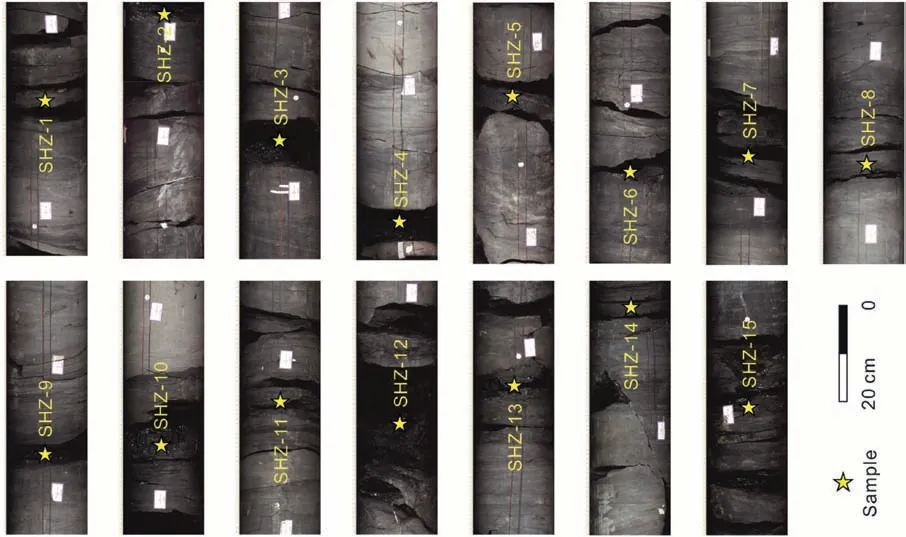
Fig. 3 Core photographs of the Shahezi Formation in borehole SK-2 showing 15 coal sample positions (yellow stars).
The inertinite/vitrinite (I/V) values of all 15 samples range from 0.28 at SHZ-2 to 0.66 at SHZ-5 with an average value of 0.42, and show three charcoalenriched intervals characterized by I/V > 0.5 at~3890 m,~3557 m,and~3407 m(Table 1),which may indicate high frequency of peatland wildfires during that time.
The mean random reflectance of vitrinite (%RoVi)can be used to characterize the rank of coal (Stach et al., 1982; Hower et al., 1996). In this study, all coal samples from the Shahezi Formation have relatively high %RoVivalues ranging from 1.02% to 1.34%with an average value of 1.15%(Table 1).This indicates that the coal rank of the Shahezi Formation coal seams from the Songliao Basin is bituminous with a high degree of coalification (Stach et al., 1982). The mean random reflectance of inertinite (%RoIn) of all 15 samples shows a narrow range from 1.21% at SHZ-2 to 2.73%at SHZ-10(Table 1),with a mean value of 1.68%.Based on the relationship between %RoInvalues and the temperature (T = 184.10 + 117.76 × %RoIn; Jones,1997; Petersen and Lindstr¨om, 2012), the burning temperature of the samples ranges from 326.7°C at SHZ-2 to 505.8°C at SHZ-10 with an average temperature of 382.3°C(Table 1).Three significant increases of %RoInvalues and burning temperature were also recognized at the episodes of high I/V values(Table 1;Fig. 6, shading intervals).
4.2. Pyrogenic polycyclic aromatic hydrocarbons (pyroPAHs)
PyroPAHs were detected in all 15 coal samples of the Shahezi Formation, including two-ring naphthalene, three-ring acenaphthylene, acenaphthene,fluorine, phenanthrene, anthracene, four-ring fluoranthene,pyrene,benz(a)anthracene,chrysene,fivering benzo(b)fluoranthene, benzo(e)fluoranthene,benzo(e)pyrene, benzo(a)pyrene, perylene, dibenzo(a,h)anthracene,six-ringbenzo(g,h,i)perylene,indeno(1,2,3-c,d)pyrene, and coronene with more or less intense methyl derivatives of the respective compounds (Fig. 7). The quantitative analyses of pyroPAHs show that total pyroPAH concentrations(TpyroPAHs)vary from 1.27 μg/g coal at sample SHZ-1 to 4.62 μg/g coal at sample SHZ-2 with an average of 2.23 μg/g coal (Table 2). Although anomalously high TpyroPAHs have not been observed in the samples, a similar pattern of increased TpyroPAHs around the position with high charcoal abundances was identified in the Shahezi Formation (Fig.6).
4.3. Total organic carbon (TOC) and organic carbon isotope (δ13Corg)
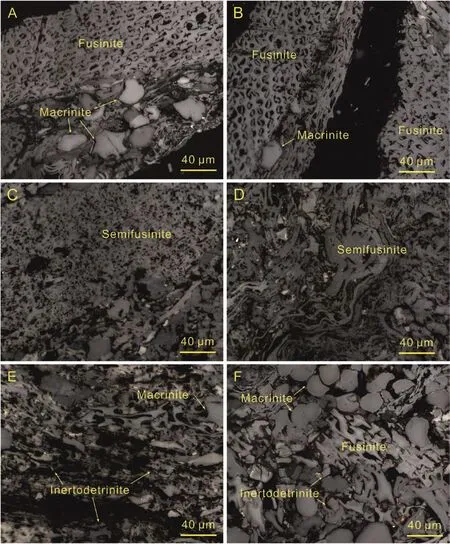
Fig.4 Inertinite photomicrographs(oil immersion,white light)of the Shahezi Formation coal seams showing high reflectivity.A-B)Fusinite and macrinite with regular and complete arrangement of cell texture from coal sample SHZ-5;C-D)Semifusinite with compressed and broken cell wall from coal sample SHZ-12; E-F) Distributed fusinite, inertodetrinite, and macrinite from coal sample SHZ-5.
The δ13Corgvalues range from −24.93‰ at sample SHZ-10 to −22.93‰ at sample SHZ-2 with an average value of −23.82‰ (Table 1). The δ13Corgvalues are stable at about −23.6‰through the lowest part of the Shahezi Formation, and then show an abrupt ~1.0‰negative excursion at ~3890 m (Fig. 6). However, the minimum of this excursion cannot be observed due to lack of samples above the depth of 3890 m. A second short-lived negative shift of~1.5‰is seen at the depth of~3557 m after a value of −23.64‰.Then the δ13Corgvalues rise again to about −23.2‰ with values stabilized at depth of ~3545-3420 m. The last negative shift of δ13Corgvalue with about 1.5‰in the top of the Shahezi Formation occurs at the depth of about 3400 m, before values stabilized at ~23.0‰ in the upper section (Fig. 6). From the bottom to the top, a total of three sharp,short-term negative δ13Corgshifts were recorded at the depth of~3890 m,~3557 m,and~3400 m, coeval with the periods marked by the increase in charcoal and pyroPAH abundance.
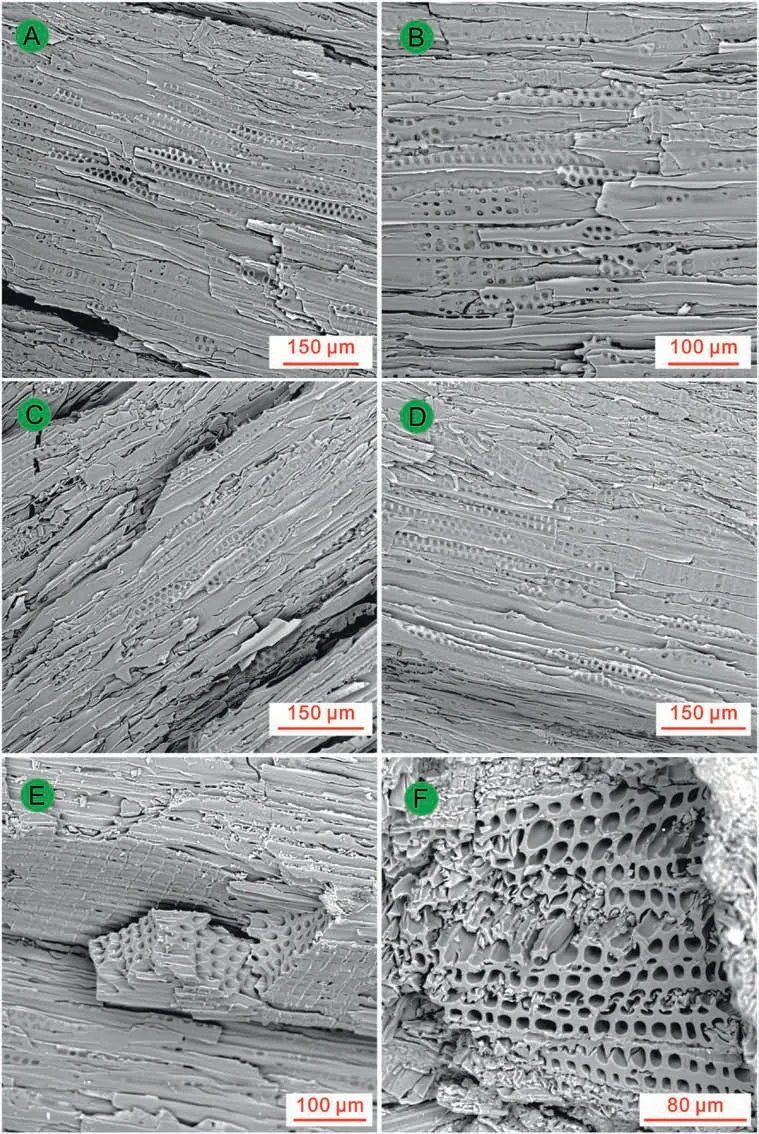
Fig. 5 SEM back-scattered images of inertinite from the Shahezi Formation coal seams showing structured and homogenized cell walls related with a wildfire origin. A-B) Anatomical characteristics with numerous multiseriate distributed pits on the tracheid walls from coal sample SHZ-5; C-D) Fractured tracheids due to compaction in radial view from coal sample SHZ-10; E-F) Conspicuously homogenized tracheid walls (in cross section) from coal sample SHZ-5.
The coal samples have high TOC contents,narrowly ranging from 50.6% to 69.3% with an average value of 56.8%. The variation of TOC contents has poor correlation with the δ13Corgshifts in the Shahezi Formation.
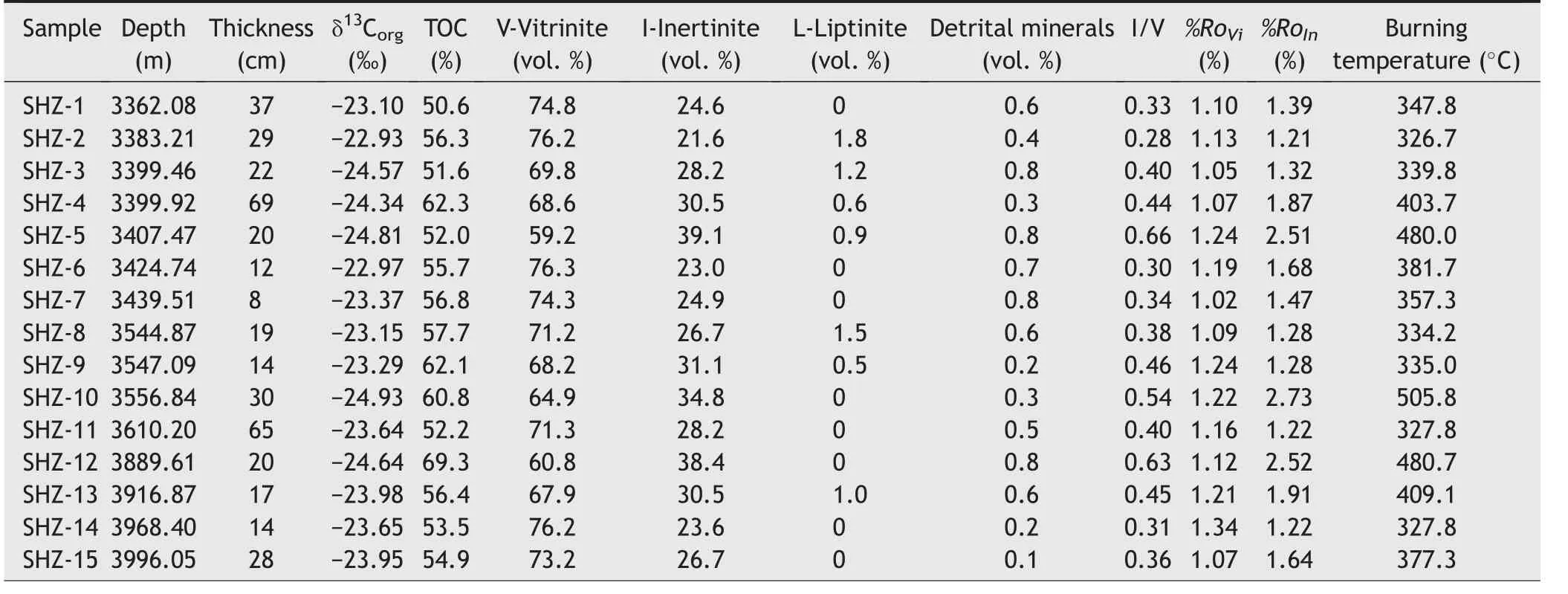
Table 1 δ13Corg, TOC,and maceral data of the studied coal samples from the Lower Cretaceous Shahezi Formation of the Songliao Basin.
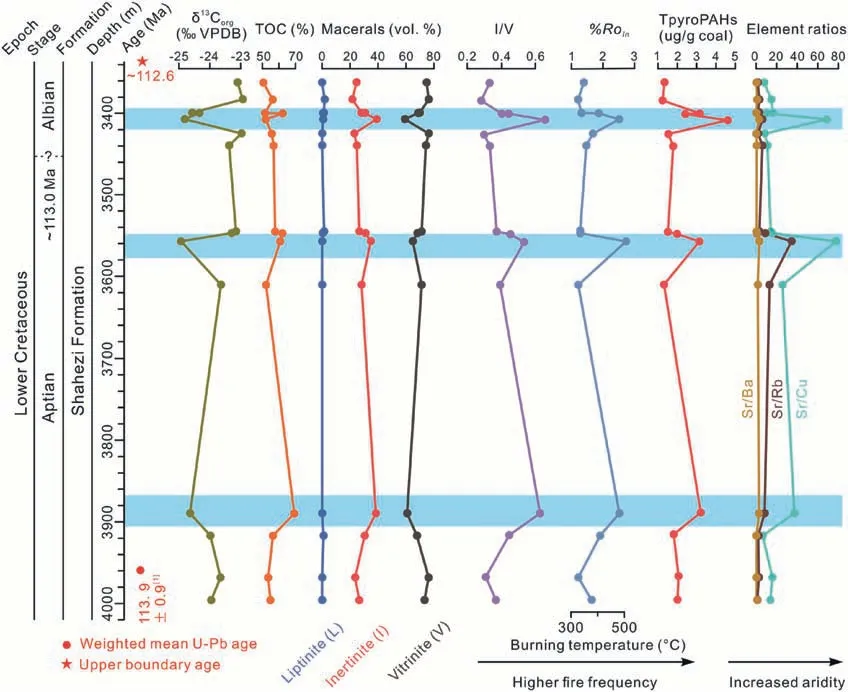
Fig.6 Stratigraphic variations of δ13Corg,TOC,macerals(L:Liptinite,I: Inertinite, V:Vitrinite),I/V, %RoIn, TpyroPAHs,and element rations(Sr/Ba,Sr/Rb,Sr/Cu).Shading intervals are characterized by negative δ13Corg shifts,higher wildfire frequency,and increased aridity.Zircon U-Pb age[1] (red dot)is from Yu et al. (2020). The upper boundary age (red star) of the Shahezi Formation was calculated using the ages of two tuff layers (Yu et al., 2020; Liu et al., 2021).

Fig. 7 Total ion current (TIC) traces of aromatic fractions of coal samples A) SHZ-3, B) SHZ-5, C) SHZ-10, and D) SHZ-12, showing high concentrations of unsubstituted pyroPAHs. IV: Phenanthrene; V: Anthracene; VI: Fluoranthene; VII: Pyrene; VIII: Benz(a)anthracene; IX:Chrysene; X: Benzo(b)fluoranthene; XI: Benzo(e)fluoranthene; XII: Benzo(e)pyrene; XIII: Benzo(a)pyrene; XIV: Perylene; XV: Benzo(g,h,i)perylene; XVI: Dibenzo(a,h)anthracene; XVII: Indeno(1,2,3-c,d)pyrene; XVIII: Coronene.
4.4. Trace elements and rare earth elements and yttrium
Trace element and rare earth element concentrations in the Shahezi Fomation coals are shown in Table 3. Compared with the values for world hard coals(Ketris and Yudovich, 2009), only Cs shows a concentration coefficient (CC = The ratio of one element concentration in investigated coals versus world hard coal,Dai et al.,2015)value of more than 10,and other elements,such as Sc,V,Cr,Ga,Rb,Sr,Mo,Ba,Th,Nb,Ta,Zr,and Hf,show slight enrichment(CC=2-5).The elements, including Be, Co, Ni, Cu, Zn, Pb, U, and Y,are nearer to the average global values (Table 3). Sr/Ba, Sr/Cu, and Sr/Rb ratios in the coal samples range respectively from 0.23 to 3.03 with an average of 1.01,from 6.4 to 77.68 with an average of 22.94, and from 1.25 to 34.41 with an average of 6.43(Table 3).These elements ratios in the Shahezi Formation exhibit similar patterns within three horizons characterized by increased charcoal and pyroPAH abundances (Fig. 6).
5.Discussion
5.1. Evidence of peatland wildfires
The Cretaceous has been considered a “high-fire”world because of widespread and frequent wildfires(e.g., Brown et al., 2012). The extensive wildfire activity has been linked to elevated atmospheric oxygen concentrations over 25% (Glasspool and Scott, 2010),which would enable wetter vegetation to ignite and continue to burn (Watson and Lovelock, 2013;Glasspool et al.,2015).Wildfires can generate a range of products that have the potential to be identified in the rock record,such as charcoal and pyroPAHs(Brown et al., 2012; Baker, 2022). In particular, charcoal records provide the most effective evidence of wildfires in Earth's history owing to being well preserved in sediments and easily distinguished through black color and streak, and silky luster in the field (Scott, 2010).Within coals, charcoal can be petrographically referred to as inertinite (e.g., Scott, 2000; Scott and Glasspool, 2007; Glasspool et al., 2015; Jerrett et al., 2015; Wang et al., 2019; Zhang et al., 2020;Wang et al., 2021b). Moreover, several studies (e.g.,Glasspool and Scott, 2010; Glasspool et al., 2015;Wang et al., 2021c) have used inertinite as a proxy to reconstruct the level of atmospheric oxygen for the past time.It should be noted that microbial and fungal oxidation of plant material after burial could also result in the formation of inertinite macerals (Hower et al., 2011; O'Keefe et al., 2013; Sen, 2016). However, Scott and Glasspool (2007) suggested that inertinite is almost exclusively the by-product of wildfires based on observations of modern charcoal assemblages and experimental charcoalification studies. In this study, high inertinite abundances in the Shahezi Formation indicate that widespread peatland wildfires were prevalent in the Songliao Basin during the middle Aptian to early Albian. Especially, three episodes of extremely high I/V values occurred in the Shahezi Formation may show a statistically significant increase in peatland wildfire activity.
PyroPAHs are recalcitrant organic compounds and have been attributed to incomplete combustionderived sources (Blumer, 1976; Lima et al., 2005;Nabbefeld et al., 2010). In sediments, increased pyroPAH concentrations can be suggested as enhanced frequency of wildfires (Youngblood and Blumer, 1975;Boudinot and Sepúlveda, 2020). In Earth's past, many phases of major greenhouse gas-induced warming events have been observed by changes in wildfire activities based on the pyroPAH records (Baker, 2022),such as the Permian-Triassic transition (Nabbefeld et al., 2010; Shen et al., 2011), the Triassic-Jurassic transition (Petersen and Lindstr¨om, 2012; Song et al., 2020), the Cretaceous OAE2 (Boudinot and Sepúlveda, 2020), and the Paleocene-Eocene Thermal Maximum (Denis et al., 2017). In this study, the pyroPAHs in coal samples of the Shahezi Formation do not show anomalously high concentrations. This may be related to the relatively high mature stage of the Shahezi Formation at more than 3 km depth in borehole SK-2 of the Songliao Basin.The rank of coals fromthe formation is bituminous with a relatively high degree of coalification, causing mass of wildfireproduced pyroPAH loss (Scott et al., 2010; Sun et al.,2017). However, the pyroPAH concentrations of the samples still recorded three moderate events of increased wildfires in the Shahezi Formation, coincident with the evidence from the charcoal occurrences.Hence, three periods of intensive peatland wildfires were recognized based on the co-occurrence of high charcoal fragment and pyroPAH abundance at~3890 m,~3557 m,and~3400 m of borehole SK-2 in the Shahezi Formation (Fig. 6).
Wildfires have been grouped into three types by different combustion temperature:1)ground fires that burn organic material below the litter with low temperature of<350°C;2)surface fires that burn litter and herbaceous and shrubby plants, producing temperature of ~600°C; 3) crown fires with intense heat that can reach temperature of 800°C or higher(Scott,1989, 2000; Petersen and Lindstr¨om, 2012). Several experimental charring studies documented that the reflectance of charcoal increases with increasing burning temperature (Scott, 1989, 2000; Jones and Chaloner, 1991; Jones, 1997; Scott and Glasspool,2006, 2007). In this study, the %RoInvalues from the samples of the Shahezi Formation range from 1.21%to 2.73% with an average of 1.68%. Based on the linear regression equation described by Jones (1997), the peatland plant material was charred at temperature between 326.7°C and 505.8°C with an average value of 382.3°C, indicating that peatland wildfires were dominated by middle-temperature surface fires during the middle Aptian to early Albian in the Songliao Basin.In addition, the three peaks of frequent peatland wildfires in Shahezi Formation were accompanied by higher burning temperature (Fig. 6).
5.2. Global correlation of carbon isotope curve during OAE1b
During the late Aptian to early Albian(~114.5-110.5 Ma),marine sediments mainly from the Tethys, Atlantic, and Pacific Ocean Basins contain several pronounced black shale horizons which are known as OAE1b (Arthur et al., 1990; Bralower et al.,1999; Leckie et al., 2002; Herrle et al., 2004;Trabucho Alexandre et al.,2011;Coccioni et al.,2014;Matsumoto et al.,2020).Unlike the OAEs(e.g.,T-OAE and OAE2) which represented discrete and relatively short-lived intervals with significant perturbations in the global carbon cycle,OAE1b is subdivided into four sub-events, including 113/Jacob, Kilian, Paquier/Urbino, and Leenhardt sub-events, characterized by organic-carbon enrichment and negative excursion of carbon isotope values (Herrle et al., 2004; Coccioni et al., 2014; Sabatino et al., 2015). Similarly,contemporaneous terrestrial records also show negative δ13Corgshifts with relatively high TOC values,corresponding with the sub-events of OAE1b(Ludvigson et al., 2010; Hu et al., 2014; Xu et al.,2022; Zhao et al., 2022). The ages for the 113/Jacob sub-event, the Kilian sub-event, the Urbino/Paquier sub-event, and the Leenhardt sub-event are respectively~114.5 Ma,~112.8 Ma,~111.1 Ma,and~110.5 Ma(Coccioni et al., 2014; Matsumoto et al., 2020). The 113/Jacob and Kilian sub-events were closest to the Aptian-Albian boundary (~113 Ma), and placed in the lower and upper boundary,respectively(Herrle et al.,2004; Coccioni et al., 2014).
In this study, there are three distinct short-term negative δ13Corgshifts respectively at ~3890 m,~3557 m,and~3400 m in the Shahezi Formation of the Songliao Basin. Based on the reported zircon U-Pb ages from tuff layers and sandstone beds, the Shahezi Formation with deposition rate at~460 m/Ma was constrained from the middle Aptian(~118 Ma)to early Albian (~112.6 Ma) (Yu et al., 2020; Liu et al., 2021).The Aptian-Albian boundary(~113 Ma)may be placed at~3470 m,close to the upper boundary of the Shahezi Formation (~112.6 Ma) (Liu et al., 2021). Therefore,the three significant negative δ13Corgexcursions in the Shahezi Formation could be counterparts of the subevents of OAE1b. The top negative δ13Corgexcursion of ~1.5‰ at about 3400 m is detected between the upper boundary of the Shahezi Formation and the Aptian-Albian boundary (Fig. 6), which can be regarded as the Kilian sub-event of OAE1b. Though the second negative δ13Corgexcursion of~1.5‰at~3557 m appears below the Aptian-Albian boundary, the stratigraphic position of these two horizons is obviously close.This negative δ13Corgshift,therefore,may be caused by a local environmental change and could not be correlated with the late Aptian 113/Jacob subevent of OAE1b.The lowest significant negative δ13Corgshift of ~1.0‰ is detected at ~3890 m and below the Aptian-Albian boundary, suggesting that the 113/Jacob sub-event equivalence is probably recorded in this interval (Fig. 8). The Urbino/Paquier and Leenhardt sub-events of OAE1b are not observed in this study, which may be recorded in the upper strata of the Yingcheng Formation in the Songliao Basin. It should be pointed out that there is only one value supporting the upper two negative δ13Corgshifts in the Shahezi Formation due to lack of samples in this study,which may cause a fallacious recognition for the perturbation in the local/global carbon cycle. However, for this study, other data in these two intervals also show distinct changes, which to some extent can support the reliability of the negative δ13Corgexcursions.
5.3. Climate change forcing of peatland wildfires during OAE1b
Many studies have identified that records of increased combustion by-products and inferred enhanced wildfire activities appeared around the major episodes of greenhouse-gas induced global warming in Earth's history(Baker,2022 and references therein).The wildfire behavior is mainly influenced by atmospheric oxygen concentration changes, climate and vegetation changes (Belcher and Hudspith, 2017;Baker,2022).The high level of atmospheric oxygen can prolong periods of increased wildfire activities over different timescales(Glasspool and Scott,2010;Baker et al.,2017).For instance,Glasspool and Scott(2010)suggested that Phanerozoic peatland wildfires were mainly controlled by concentrations of atmospheric oxygen over long geological timescales. In addition,Baker et al. (2017) found that a sustained ~800 kyr enhancement of fire-activity beginning ~1 Myr after the onset of the T-OAE was primarily driven by a rise in atmospheric oxygen. Nevertheless, variations in wildfire activity can be also closely linked with CO2-induced climate changes by various processes,such as regional climate aridification (Song et al., 2020),suppression of the hydrological cycle (Baker et al.,2020), increasing lightning strikes (Belcher et al.,2010), enhancing fuel availability (Denis et al., 2017;Feurdean and Vasiliev, 2019; Fletcher et al., 2019).
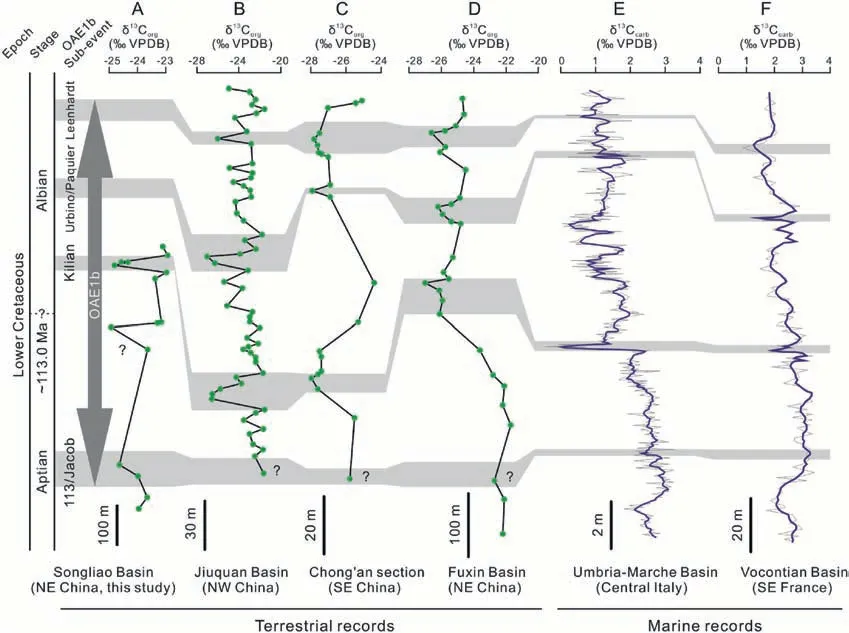
Fig. 8 Correlation/comparison of OAE1b carbon isotopic changes in terrestrial records, including Songliao Basin, NE China (this study),Jiuquan Basin, NW China (Zhao et al., 2022), Chong'an section, SE China (Hu et al., 2014), and Fuxin Basin, NE China (Xu et al., 2022); and marine records, including Umbria-Marche Basin, Central Italy (Coccioni et al., 2014) and Vocontian Basin, SE France (Herrle et al., 2004).Time-equivalent sub-events (113/Jacob, Kilian, Urbino/Paquier, and Leenhardt) of OAE1b are correlated with shading intervals.
In this study, the 113/Jacob and Kilian sub-events of OAE1b have been detected in the Shahezi Formation of the Songliao Basin.Moreover,higher abundance of coal combustion by-products (e.g., charcoal and pyroPAHs) in the same horizon can indicate enhanced peatland wildfires in the mid-latitude terrestrial region across the sub-events of OAE1b. As discussed above, the frequent and intense peatland wildfires during episodes of the sub-events of OAE1b may be affected by atmospheric oxygen concentrations,climate conditions, and fuel availability (Baker, 2022 and references therein). The mid-Cretaceous OAE1b occurred during a time when modeled atmospheric O2concentrations were ~25% (Lenton et al., 2018),enabling wetter fuel to carry wildfires (Watson, 1978;Watson and Lovelock, 2013). However, there is no research on high-resolution atmospheric O2concentrations of OAE1b to support increased peatland wildfire activity through rising atmospheric O2conditions at that time. Although the middle to late Cretaceous was a time of dramatic vegetational change with the rising dominance of angiosperms (Niklas et al.,1983; Lidgard and Crane, 1990; Lupia et al., 1999),the slight shifts of vegetation type may have not driven variations in wildfire behavior during the relatively short period of OAE1b. Moreover, peat-forming environments selected for this study are favored vegetation growth, creating great fuel loads and continuity.Therefore, for this study, climate condition change that controlled fuel state(moisture content)may be a primary driving force behind increased wildfires activity.
The ratios of elements Sr, Cu, Ba, and Rb can be applied for the reconstruction of paleoclimate conditions(Lerman,1978;Mathews et al.,2020).High ratios of Sr/Ba, Sr/Cu, and Sr/Rb often indicate drier climate, while low ratios represent more humid climate (Lerman, 1978; Chen et al., 2000; Mathews et al., 2020). However, high Sr enrichment can not only be formed by concentrated water in arid and hot climates but also be related to sea water in humid climate(Lerman,1978).In this study,the coal seams of the Shahezi Formation in the Songliao Basin were deposited in terrestrial environment (Feng et al.,2010). Moreover, their elements (apart from Cs) show only slight enrichment or nearer to the average values of world hard coals(Ketris and Yudovich, 2009) (Table 3). Hence, the Sr/Ba, Sr/Cu, and Sr/Rb trends of the coal samples in the Shahezi Formation indicate that dryer climate conditions were in accordance with episodic peatland wildfire frequency during OAE1b(Fig. 6). According to the calcareous nanofossil temperature index, surface water hyperthermals were occurred in the sub-event intervals of OAE1b (Bottini and Erba, 2018). The global temperature rise may correspond to the northward migration of arid zones and the reorganization of atmospheric circulation over East Asia(Boucot et al.,2009,2013;Deng et al.,2012;Wang et al., 2013; Gao et al., 2015, 2021), causing a period of dry climate allowing for frequent peatland wildfires in the Songliao Basin during OAE1b (Fig.9).
5.4. Implications for driving mechanism of OAE1b
Massive volcanic episodes have been considered as the significant trigger of environmental perturbations,including the mass extinction events, sea level changes, and OAEs (Leckie et al., 2002; Shen et al.,2019; Matsumoto et al., 2022). Previous studies suggested that OAE1b was attributed to extreme greenhouse warming caused by massive release of CO2related to extensive volcanism in the Southern Kerguelen Plateau basalt (Coffin and Eldholm, 1994;Coffin et al., 2002; Sabatino et al., 2018). However,during OAE1b, the asynchronism was occurred between carbon isotopic negative shifts and volcanic activities reflected by both mercury(Hg) enrichments and osmium isotopic records (187Os/188Os) (Benamara et al., 2020; Matsumoto et al., 2020; Xu et al., 2022;Zhao et al., 2022), indicating that rapid influx of CO2into the atmosphere may be related with other sources, such as thermogenic and methane hydrate releases(Hesselbo et al.,2000;McElwain et al.,2005;Xu et al., 2022; Zhao et al., 2022). Under high CO2and greenhouse climate condition, an accelerated hydrological cycle and intensified chemical weathering lead to more nutrient and organic matter transporting into lakes and oceans where improved productivity in surface water can cause prevailing anoxic condition,accompanied by organic-rich deposition(Leckie et al.,2002; Herrle et al., 2003; Jenkyns, 2010; Benamara et al., 2020; Xu et al., 2022).
In the modern day, many studies have shown that key nutrients (e.g., phosphorus) required by primary producers can be increased significantly in the day following a fire in nearby streams,which feed into the marine environment (Spencer and Hauer,1991;Taylor et al., 1993; Baker, 2022). Kump (1988) has hypothesized a fire-phosphorous feedback cycle, that is,increasing fire leads to the phosphorous influx increase into the lacustrine and ocean by high level of runoff and erosion, and aerosol inputs in the atmosphere as smoke (Yan et al., 2019; Baker et al., 2020). This fire-phosphorous feedback cycle allows elevated algal productivity that in turn promotes widespread anoxia,leading to the deposition of organic-rich sediments called OAEs(Berrocoso et al.,2010;Kraal et al.,2010;Brown et al., 2012; Yan et al., 2019).
In this study, during the sub-events of OAE1b,climate-driven intense peatland wildfire activity in the Shahezi Formation of the Songliao Basin might indicate that frequent wildfire behavior possibly occurred in the mid-latitude terrestrial ecosystems at that time.Therefore, high wildfire activity through climatic warming and drying,which resulted in massive flushed phosphorous into the lakes and oceans that in turn enabled the rapid growth of plankton, could be a contributing factor for OAE1b.
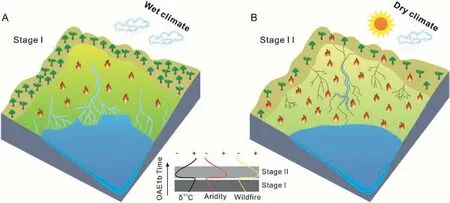
Fig. 9 Conceptual model for climate change forcing of peatland wildfires during OAE1b in the Songliao Basin.
6.Conclusions
A total of 15 coal seams from the continental Lower Cretaceous Shahezi Formation intersected by borehole SK-2 in the Songliao Basin were analyzed for evidence of peatland wildfire activities during OAE1b.The main conclusions are summarized as follows:
1) Three distinct short-term negative shifts of δ13Corgwere identified in the coal seams of the Shahezi Formation.Based on the accurate zircon U-Pb ages of the previous studies, two negative δ13Corgexcursions were inferred as the counterparts of the 113/Jacob and Kilian sub-events of OAE1b.
2) The co-occurrence of high charcoal and high pyro-PAH abundance was recognized at the periods of negative δ13Corgshifts in the Shahezi Formation,indicating that intensive peatland wildfires occurred in the Songliao Basin during the corresponding sub-events of OAE1b.
3) The Sr/Ba,Sr/Cu,and Sr/Rb ratios show that drier climate intervals during the Shahezi Formation deposition in the Songliao Basin were in accordance with increased peatland wildfire frequency. This may be related with the episodic northward migration of arid zones in East Asia caused by global temperature rising during the sub-events of OAE1b.
4) Climate-driven high wildfire activity in the midlatitude terrestrial ecosystems would have engendered increased phosphorous amounts into lakes and oceans, leading to elevated plankton productivity and subsequent widespread anoxia with organic-rich deposition during OAE1b.
Funding
This study was financially supported by the National Natural Science Foundation of China(Grant Nos.42102127, 42172117, 41772096), the Natural Science Foundation of Shandong Province (Grant No.ZR2021QD087), the Chinese Postdoctoral Science Foundation (Grant No. 2021M702019), and the SDUST Research Fund, Shandong University of Science and Technology(Grant No. 2018TDJH101).
Availability of data and materials
The data that support the findings of this study are available on request from the corresponding author.
Authors' contributions
All the authors have actively participated in the preparation of the manuscript. ZHZ is responsible for data curation and manuscript preparation; DWL has charge of funding acquisition, project administration and supervision; TTW is responsible for conceptualization and methodology; DZA is responsible for visualization and investigation; HYL is responsible for investigation and supervision; DDW is responsible for software analysis and validation; CSW has charge of reviewing and edition updating. All authors read and approved the final proof.
Conflicts of interest
The authors declare that they have no competing interests.
Acknowledgements
We would like to thank the Editor-in-Chief of JOP,Prof. Zeng-Zhao Feng, and two anonymous reviewers for their constructive comments. We are also grateful to Dr. Yuan Gao from CUGB for his valuable technical support.
杂志排行
Journal of Palaeogeography的其它文章
- Research status of lacustrine mudrock deposition constrained from astronomical forcing
- Origin of soft-sediment deformation structures in Nihewan Basin
- Diagenetic mineralogy and its effect on the reservoir properties of the sandstones of the Permian of S120 block (Sulige gas field), Ordos Basin, NW China
- Hydroclimate changes related to thermal state of the tropical Pacific in the northern coast of the South China Sea since ~8000 cal yr B.P.
- Petrography and tectonic provenance of the Permian Tunas Formation: Implications on the paleotectonic setting during the Claromec′o Foreland Basin evolution, southwestern Gondwana margin, Argentina
- Clay mineral formation and transformation in non-marine environments and implications for Early Cretaceous palaeoclimatic evolution:The Weald Basin, Southeast England
